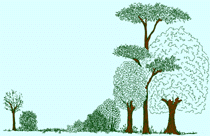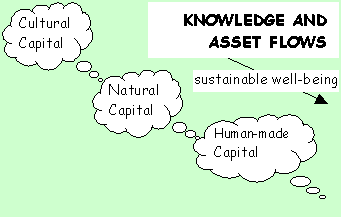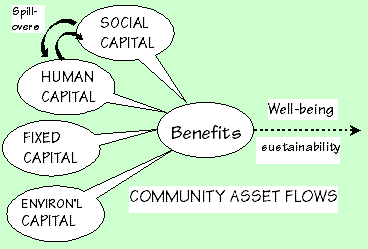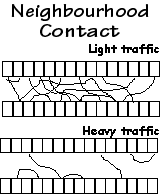 |
||
|
When economists think of sustainability, they deal in their familiar terms of assets or capital, their productive uses and the benefits that flow from them that provide well being. Assets and capital have the same meaning in this context of being resources. In standard economics, the resources would be monetary, or exchangeable or tradable goods. In recent years, standard economic theory has been broadened by ecological economists to include natural and even human/social assets or capital and their interrelationships. NATURAL CAPITAL can be said to consist of three major components: 1. NON-RENEWABLE RESOURCES such as oil and minerals that are extracted from ecosystems, 2. RENEWABLE RESOURCES such as wild food harvests (i.e. fish) wood, and drinking water. These are produced and maintained by the processes and functions of ecosystems, 3. ENVIRONMENTAL SERVICES such as maintenance of a breathable atmosphere, regulation of climate, production and maintenance of soil and operation of the water cycle. HUMAN-MADE CAPITAL is generated via economic activity through human ingenuity and technological change - the produced means of production. It is not possible for human ingenuity to create human-made capital without the support and resources from natural capital. But having linked these two capitals, where now is our formula that integrates them together in sustainability? Two ecological economists (Fikret and Folke, Ecological Economics, Vol. 5 No.1, October 8 1991) have recognised an additional capital that they believe when integrated could provide the benefits of well being in a sustainable way. CULTURAL CAPITAL refers to factors that provide human societies with the means and adaptations to deal with the natural environment and to actively modify it. This includes how people view the world and the universe; environmental philosophy and ethics; traditional ecological knowledge; and social and political institutions.
Cultural capital covers the wide variety of
ways in which societies interact with their The World Bank has also promoted a model for sustainable well being based on the stocks of social assets or capitals. The Bank is owned by 182 member countries, and its purpose is to reduce poverty and to help people help themselves and their environment by providing resources, sharing knowledge, building capacity, and forging partnerships in the public and private sectors. Their model has a natural capital and three other capitals that are variations on those above:
SOCIAL CAPITAL is the level of trust between people and the amount of help and support within a community HUMAN CAPITAL is the stock of skills and qualifications as they relate to people’s ability to do work, and thus must also include their health FIXED OR PHYSICAL CAPITAL is made up of homes, roads, schools, hospitals, factories and machinery The
model is based on the principle that none of the capitals are
complimentary – investing
SOCIAL CAPITAL is the glue that holds
societies together Mark Fisher - Permaculture Design course handout notes www.self-willed-land.org.uk mark.fisher@self-willed-land.org.uk -top |


 more in one will not compensate or substitute
for lack of investment or a loss in another. There are, however,
spillovers (crossovers) that can arise between the capitals, and
it is important that these always be positive (i.e.
beneficial) rather than negative or harmful. Poor housing
(fixed capital) can cause ill health (human capital). A good
shared open space in a community (environmental capital) can
provide more opportunities for communities to meet together
(social capital). A traffic-calming scheme (fixed capital
and environmental capital) can increase social interaction
in a street (social capital – see schematic).
more in one will not compensate or substitute
for lack of investment or a loss in another. There are, however,
spillovers (crossovers) that can arise between the capitals, and
it is important that these always be positive (i.e.
beneficial) rather than negative or harmful. Poor housing
(fixed capital) can cause ill health (human capital). A good
shared open space in a community (environmental capital) can
provide more opportunities for communities to meet together
(social capital). A traffic-calming scheme (fixed capital
and environmental capital) can increase social interaction
in a street (social capital – see schematic).